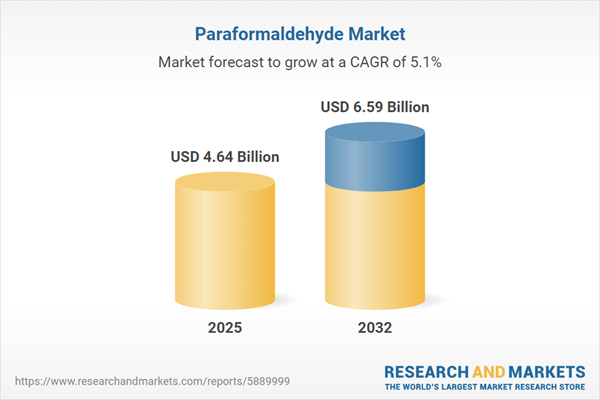Speak directly to the analyst to clarify any post sales queries you may have.
The paraformaldehyde market is evolving rapidly as enterprises adapt to shifting regulations, intensifying innovation requirements, and modernized supply strategies. Senior decision-makers are redefining operational models and supply resilience to secure efficiency and future-readiness in an industry undergoing consistent change.
Market Snapshot: Global Paraformaldehyde Market Growth and Dynamics
The global paraformaldehyde market achieved USD 4.42 billion in 2024 and is projected to reach USD 4.64 billion by 2025, tracking a compound annual growth rate (CAGR) of 5.11% through 2032. Continued demand stems from core uses in resin manufacturing, advanced adhesive production, and applications spanning personal care and disinfection solutions. Paraformaldehyde remains a cornerstone for chemical synthesis across multiple industrial sectors, requiring precise coordination between compliance, supply chain agility, and product customization to remain competitive.
Scope & Segmentation of the Paraformaldehyde Market
- Applications: Includes adhesives, cosmetics, personal care products, pharmaceuticals, agricultural disinfectants, chemical synthesis processes, and resin manufacturing. These uses drive relevance across various industrial and consumer goods markets as organizations address specialized performance and regulatory requirements.
- End Use Industries: Comprises adhesives and sealants, agriculture, pharmaceuticals, and cosmetics. Each sector demands reliable product quality standards, strict compliance, and efficiency to maintain resilience within individual regulatory and operational frameworks.
- Physical Forms: Available as pellets and powders to optimize logistics and manufacturing, catering to both small-volume and large-scale industrial operations.
- Purity Grades: Offered in high-purity, laboratory, and technical grades to support a broad spectrum of applications, including production lines, research and development, and medical or specialty use.
- Packaging Types: Supplied in bags, drums, and bulk containers, enabling tailored storage and transport aligned with company scale and distribution models.
- Distribution Channels: Utilizes direct supplier agreements and distributor networks to ensure reliable delivery flows and commercial confidentiality, securing uninterrupted access for end-users.
- Regional Coverage: Market presence spans the Americas, Europe, Middle East and Africa, and Asia-Pacific regions. Local operating climates, the speed of technology integration, and regional logistics strategies shape business outcomes and adaptation requirements.
- Key Companies Profiled: BASF SE, Jining Rainbow Chemical Co., Ltd., OQ Chemicals GmbH, Arclin, Inc., Huntsman International LLC, Denka Company Limited, Shandong Yaxing Bio-Chemical Co., Ltd., Yuntai Chemical Group Co., Ltd., Puyang Zhongtian Chemical Group Co., Ltd., and Merck KGaA.
Key Takeaways for Senior Decision-Makers
- Commitment to compliance and robust quality assurance is essential for uninterrupted supply and consistent performance, notably in sectors such as engineered wood, adhesives, and chemical synthesis.
- Heightened attention to health, hygiene, and disinfection amplifies the need for transparent supply sourcing and strict regulatory alignment, becoming especially important in markets sensitive to consumer and safety demands.
- Responsive adaptation to policy shifts and investment in advanced processing solutions accelerate market entry and support rapid product innovation in dynamic environments.
- Establishing or expanding local manufacturing capacity and developing bio-based chemical derivatives enhance supply chain flexibility and support long-term sustainability priorities for multinational operations.
- Effective partnerships between suppliers and buyers foster agility and preparedness amid evolving regulatory and market conditions.
- Supplying high-purity and technical-grade paraformaldehyde enables producers to fulfill complex standards in pharmaceutical and personal care segment manufacturing, widening competitive differentiation.
Tariff Impact: Navigating Policy and Supply Chain Adjustments
Global shifts in tariff regimes prompt manufacturers to focus on localizing sourcing strategies, reinforcing regional supplier relationships, and optimizing inventory controls. Enhanced supply chain and inventory management practices are increasingly vital to stability, minimizing disruptions linked to fluctuating international trade policies and changing import/export scenarios.
Methodology & Data Sources
This market assessment synthesizes findings from direct executive interviews alongside comprehensive secondary research. Rigorous review of industry publications, trade records, and current policy frameworks supports validity and relevance for paraformaldehyde market participants.
Why This Paraformaldehyde Market Report Matters
- Equips senior leaders with focused insights on paraformaldehyde market shifts, regulatory trends, and proven compliance practices for shaping informed strategies.
- Delivers comprehensive segmentation and regional detail to support precise risk management, resource planning, and investment in new product lines.
- Supports decision-makers in anticipating competitive changes and adjusting to critical supply chain developments for confident, future-oriented leadership.
Conclusion
Effective participation in the paraformaldehyde market depends on proactive strategy and vigilant adaptation. Reliable data and agile operational adjustments help organizations secure their position and meet evolving industry expectations.
Additional Product Information:
- Purchase of this report includes 1 year online access with quarterly updates.
- This report can be updated on request. Please contact our Customer Experience team using the Ask a Question widget on our website.
Table of Contents
3. Executive Summary
4. Market Overview
7. Cumulative Impact of Artificial Intelligence 2025
List of Figures
Companies Mentioned
The companies profiled in this Paraformaldehyde market report include:- BASF SE
- Jining Rainbow Chemical Co., Ltd.
- OQ Chemicals GmbH
- Arclin, Inc.
- Huntsman International LLC
- Denka Company Limited
- Shandong Yaxing Bio-Chemical Co., Ltd.
- Yuntai Chemical Group Co., Ltd.
- Puyang Zhongtian Chemical Group Co., Ltd.
- Merck KGaA
Table Information
| Report Attribute | Details |
|---|---|
| No. of Pages | 198 |
| Published | November 2025 |
| Forecast Period | 2025 - 2032 |
| Estimated Market Value ( USD | $ 4.64 Billion |
| Forecasted Market Value ( USD | $ 6.59 Billion |
| Compound Annual Growth Rate | 5.1% |
| Regions Covered | Global |
| No. of Companies Mentioned | 11 |









